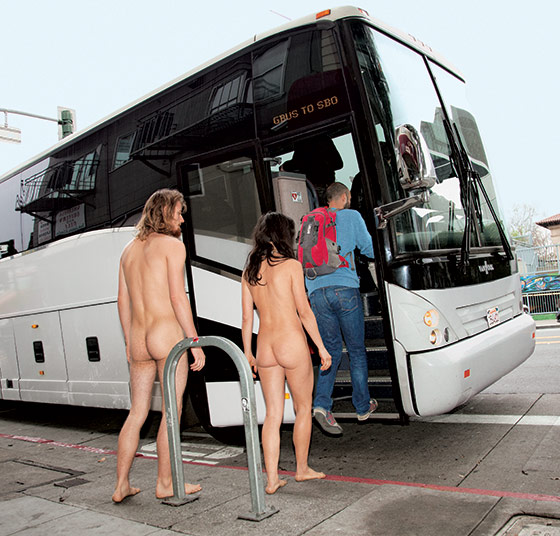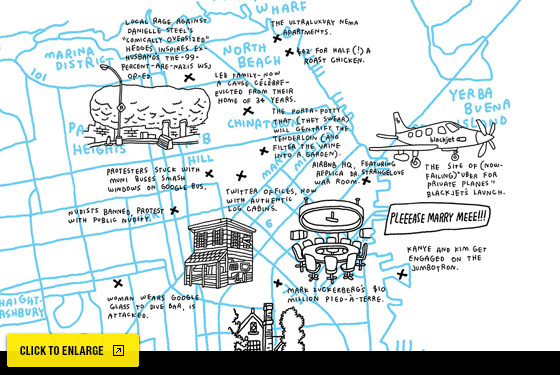
It’s hard to pinpoint the exact moment that San Francisco morphed into bizarro-world New York, when it went from being the city’s dorky, behoodied West Coast cousin to being, in many ways, more New York–ish than New York itself—its wealth more impressive, its infatuation with power and status more blinding. Maybe it was this past November, when New York elected a tax-the-rich progressive as mayor and, two days later,Twitter, a company that had been courted by San Francisco politicians with a Bloombergian combination of municipal tax breaks and mayoral flattery, went public at around a $25 billion valuation. Maybe it was when, after the crash, bonus-starved Wall Street bankers started quitting their jobs and heading to the Bay Area in droves to join the start-up gold rush. Or maybe it was when San Francisco became the new American capital of real-estate kvetching, thanks to supra-Manhattan rents and gentrification at a pace that would make Bushwick blush.
For me, the epiphany came in December, when I attended a party at a seven-story San Francisco townhouse. The house—used as an office and party pad by a young entrepreneur who had sold his start-up for millions a few years earlier—was the kind of bachelor pad Richie Rich might have set up for himself, had he been 23 and a Burning Man regular. The walls were covered in inspirational phrases (FOLLOW YOUR HEART, HOLISTIC MINDFULNESS & WELLNESS), and the party was centered on a split-level pool and hot tub that took up the entire middle section of the house. Five inflatable killer whales floated idly in the water. A bearded man was giving out back massages at water’s edge using a pair of repurposed automotive buffers, one in each hand. And loaner swimsuits—washed between wearings, we were assured—were provided for all.
As the hours ticked on and the booze kicked in, some shed their Louboutin heels and jumped in the pool; others marinated in the hot tub and told start-up war stories. It was the kind of bash you’d have found in Easthampton circa 2006, or West Egg circa 1922. And as if to cement San Francisco’s newfound place at the center of a certain social universe, the person greeting newcomers at the door was Julia Allison, the notorious glam blogger, whose smile had dotted the New York party scene just a few years earlier.
It’s no secret that New York is having a bit of an identity crisis these days. Wall Street lost its swagger during the crash and hasn’t gotten it back despite the market’s broader recovery. Big banks are adding employees in Bangalore and Salt Lake City while cutting them in Manhattan. New York City’s budget wonks expect the city to add only 67,000 jobs this year, a sluggish number that faster-growing cities like Denver and Austin will look upon with pity. The city’s culture seems to be changing, too: Greenpoint and “normcore” are in, stilettos and pinstripes are out; junior bankers now get Saturdays off; “work-life balance” is no longer a euphemism for sloth.
Meanwhile, certain pockets of San Francisco have become the sort of gilded playground that New York once was. Brand-new Teslas with vanity plates like DISRUPTD drift down the streets of the Mission District, where pawnshops and porn stores used to be. Paper millionaires spend their nights at the Battery, a members-only club with a tech-heavy roster and a $10,000-per-night penthouse suite. Upscale restaurants pop up at regular intervals, each with a more elite clientele and a more Portlandia-esque menu—everything from the $4 artisanal toast that sparked a citywide craze to the underground supper clubs serving kombucha pairings with sustainable-seafood dinners. Finding an affordable apartment in the city has become, as one tech worker lamented to me recently, “a Hunger Games scenario.”
In many ways, San Francisco is the nation’s new success theater. It’s the city where dreamers go to prove themselves—the place where just being able to afford a normal life serves as an indicator of pluck and ability. I had lunch the other day with a Harvard Business School student who belonged to a 90-person section, of whom 12 were start-up entrepreneurs. You can imagine the whole dozen packing their bags for the West Coast after collecting their M.B.A.’s, thinking: If I can make it there, I’ll make it anywhere.
Which isn’t to say that San Francisco has pulled off this transition effortlessly. The city still has its lefty legacy, after all, and as the tech sector has grown into an economic powerhouse, so has resentment toward its elites. Protesters, angry about Silicon Valley’s effect on the local economy, are blockading tech-employee shuttles in the streets; in Oakland last year, a Google bus had its window shattered by a rock. San Francisco Mayor Ed Lee, long suspected of being in the tech industry’s pocket, is accused of not doing enough to help the working class cope with rising costs and widening inequality. Although most right-thinking one-percenters cringed when venture capitalist Tom Perkins compared the treatment of the rich in San Francisco to the treatment of Jews by Nazis on Kristallnacht, the hostility he felt is real. Silicon Valley is exploding, as Wall Street did in the 1980s, as Detroit did in the 1940s. And as in those booms, not everyone is going along for the ride.

Boomtown
A sightseeing map of San Francisco’s New Gilded Age, prepared by our friends and future overlords at San Francisco Magazine.
Of course, San Francisco won’t truly become New York, and not just because New York’s economy is nearly twice as big as the country’s next biggest (that’s L.A.’s, not San Francisco’s, which ranks eighth). San Francisco is too earnest, too eager to be liked, to truly wallow in its wealth like Bloomberg’s New York. (If Martin Scorsese had made The Wolf of Silicon Valley, it would have been two hours of Leonardo DiCaprio apologizing for spilling the Dom Pérignon.) The utopian streak of the tech sector paints a thick veneer of do-gooderism over even the rawest capitalistic conquests, and coupled with a desire to appease the locals, it’s what keeps San Francisco’s ruling class from really letting go.
My New York friends tend to brush off what’s happening in San Francisco with one word: bubble. After all, people flocked to Silicon Valley in 1999, they say, only to be flung back to New York when the start-up scene burst. But what if this tech bubble doesn’t end in sock puppets and Schadenfreude? What if, as MIT professors Erik Brynjolfsson and Andrew McAfee recently wrote, we’re not just dealing with a temporary tech craze but the dawn of a “second machine age” that will fundamentally realign the entire global economy? And what if most of the technology that powers that revolution is made in California?
Whatever the Silicon Valley gold rush has done or will do, it’s already given us an entirely new species of yuppie mogul: the one who stockpiles bitcoin and speaks in hacker pidgin, the one who wears Uniqlo on a Gulfstream and obsesses over single-origin coffees. The kind, in other words, who plays the underdog even while sitting on top of the world.